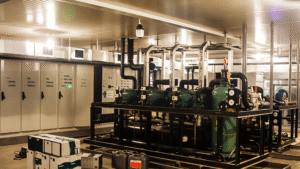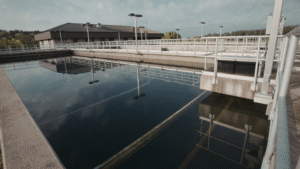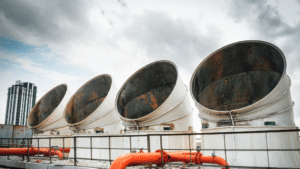Cooling towers are vital to many industrial operations, from power plants to manufacturing facilities, because they regulate heat loads and keep equipment operating efficiently. However, the same conditions that make cooling towers effective also create an ideal environment for biological growth. Warm water, nutrients, and constant circulation allow bacteria, algae, and fungi to multiply quickly, forming biofilms that interfere with performance and pose serious health risks.
This is why the use of a cooling tower biocide is essential. Biocides are chemical agents designed to control bacteria, kill microorganisms, and reduce microbial activity within cooling water systems. Without proper treatment, biological growth can compromise system reliability, increase maintenance costs, and even lead to outbreaks of Legionella bacteria, which are linked to Legionnaires’ disease.
In this article, we will explore why biocides are critical in cooling water treatment, the types available, and the best practices for their use. By understanding the role of biocides, operators and engineers can ensure safer, cleaner, and more efficient tower water treatment.
Why Biocides Are Essential in Cooling Towers
Cooling towers provide an environment where microbial growth can flourish if left untreated. Warm water, dissolved nutrients, and exposure to the atmosphere combine to encourage the proliferation of various bacteria, fungi, and algae. This unchecked biological activity creates several problems for facilities:
- Biofilm formation – Microorganisms attach to surfaces inside the system, creating layers that reduce heat transfer efficiency. This increases energy consumption, restricts water flow, and drives up operating costs.
- Health risks from Legionella bacteria – Contaminated cooling tower water can aerosolize and spread Legionella, the bacteria responsible for Legionnaires’ disease. This poses serious safety concerns for workers and surrounding communities.
- Process contamination – Biological activity disrupts water chemistry, allowing unwanted organic matter and microbial byproducts to contaminate processes that rely on clean water.
- Corrosion and equipment damage – Microbes produce acids and other metabolites that attack metal surfaces, accelerating corrosion and reducing equipment lifespan.
- Reduced cooling performance – Clogged piping and restricted circulation caused by biological growth compromise overall tower efficiency.
The ultimate objective of effective cooling tower water treatment is to use biocides to control bacteria, kill microorganisms, and prevent these challenges before they escalate. By maintaining clean, biologically stable water systems, facilities can protect both equipment and people while ensuring reliable operations.
Learn more on our blog: The Hidden Costs of Poor Cooling Tower Chemical Treatment: A Chemical Blender’s Perspective
Types of Cooling Tower Biocides
Biocides are categorized into two main groups: oxidizing and non-oxidizing. Each plays a distinct role in controlling biological growth within cooling water systems. A balanced program often combines both to maximize effectiveness.
Oxidizing Biocides
Oxidizing biocides work by using an oxidizing agent to attack and destroy microbial cell walls. These chemical substances act quickly and are highly effective against a broad spectrum of organisms.
Common examples include:
- Chlorine and free chlorine products
- Chlorine dioxide
- Bromine
- Ozone
Key characteristics of oxidizing biocides:
- Provide rapid microbial control in the bulk water
- Effective at killing planktonic bacteria before they attach to surfaces
- Often used in continuous feed or shock-dosing strategies
- Cost effective for routine microbial growth management
However, oxidizing biocides may lose effectiveness when water pH levels are high or when total organic carbon is elevated. They are also less effective at penetrating established biofilms.
Non-Oxidizing Biocides
Non-oxidizing biocides use different mechanisms of action, targeting microorganisms by interfering with vital cellular processes such as stopping respiration or disrupting enzyme activity.
Examples include:
- Isothiazolinones
- Glutaraldehyde
- DBNPA
Key characteristics of non-oxidizing biocides:
- Effective against resistant or sessile bacteria that thrive within biofilms
- Can penetrate biofilms where oxidizing agents may fail
- Typically fed intermittently rather than continuously
- Useful for controlling specific microbial populations that adapt to oxidizers
While generally more expensive, non-oxidizing biocides are essential for targeting microorganisms that survive standard oxidizing treatments.
Combining Both Approaches
Most tower systems benefit from a program that alternates oxidizing and non-oxidizing biocides. This rotation helps prevent microbial resistance, ensures broader coverage against various bacteria, and provides consistent protection for cooling water.
Best Practices for Biocide Selection & Application
Choosing the right cooling tower biocide requires more than simply adding chemicals to the system. Effective programs depend on careful evaluation, monitoring, and application methods that account for the unique conditions of each cooling water system.
1. Assess System Conditions
- Measure water pH, temperature, and total organic carbon levels, as these factors influence biocide effectiveness.
- Evaluate water flow to identify stagnant areas or dead legs where microbial growth and biofilm continue to develop.
- Consider the quality of makeup water, which can introduce nutrients and microorganisms that begin multiplying quickly.
2. Determine Feed Strategy
- Continuous feed (fed continuously): Provides a steady supply of oxidizing agents like chlorine dioxide or free chlorine for bulk water control.
- Intermittent feed (fed intermittently): Delivers non-oxidizing biocides in targeted doses, particularly effective against sessile bacteria and biofilm formation.
- Alternating between the two prevents microbial adaptation and maintains effective control.
3. Address Resistance and Biofilms
- Rotate between oxidizing and non-oxidizing treatments to manage microbiological growth.
- Select biocides that can penetrate biofilms and target both planktonic bacteria and sessile organisms.
- Monitor bacteria levels regularly to adjust treatment as microbial activity fluctuates.
4. Safety and Compatibility
- Ensure that chosen biocides do not negatively interact with other chemicals used in the cooling water treatment program.
- Address safety concerns by training operators on proper handling and storage of biocides.
- Follow regulatory guidelines to minimize environmental impact.
5. Monitor and Adjust Regularly
- Track microbiological activity through dip slides, ATP testing, or online monitoring systems.
- Document trends in biological activity and adjust dosing schedules to achieve consistent microbial control.
- Align treatment with the ultimate objective of protecting equipment, maintaining heat transfer efficiency, and ensuring safe operation.
By applying these best practices, facility managers can keep cooling water systems free from biological growth, reduce operational risks, and achieve cost-effective performance.
ETI’s Expertise in Cooling Tower Biocide Programs
At Eastern Technologies, Inc. (ETI), supporting water treatment professionals with reliable, high-performance biocide solutions is a core focus. ETI is not a competitor to service companies, but rather a trusted partner and supplier, offering one of the most comprehensive product lines in the region.
Through its distributor role with several leading microbiocide manufacturers, ETI provides access to over 35 proven chemistries. These include both oxidizers and non-oxidizers, complemented by surfactants and biopenetrants that improve performance against biofilms. ETI is also recognized as a leading distributor of liquid and solid bromine products, helping clients select effective oxidizing agents for consistent microbial control.
For service companies that require more flexibility, ETI also private labels biocides and provides assistance with regulatory requirements, such as US-EPA supplemental registrations and state-specific approvals. In addition, ETI offers microbial control test kits, including the Glutatect WT Test Kit for measuring glutaraldehyde residuals and the HMB X System for predictive biofilm monitoring. These tools help treatment professionals verify dosing strategies and adjust programs with confidence.
Whether a cooling water system is challenged by process contamination, airborne microorganisms, or concerns about Legionella, ETI’s role is to ensure that the right biocide program is chosen and applied correctly.
Learn more about ETI’s solutions on the Biocides.
Conclusion
Selecting and applying the right cooling tower biocide is critical to maintaining safe, efficient, and reliable operations. By combining oxidizing and non-oxidizing options, monitoring bacteria levels, and following best practices, facilities can minimize biological growth, protect system performance, and reduce risks tied to health and safety.
The goal is not simply to kill microorganisms, but to maintain long-term microbial control in a cost effective and sustainable way. When approached strategically, biocide treatment keeps cooling water systems clean, extends equipment life, and safeguards against threats like Legionella and biofilm formation.
Partner with ETI for expert support. Serving Pennsylvania and Ohio industries for nearly four decades, Eastern Technologies, Inc. provides proven biocide chemistries, private-label programs, and technical guidance to water treatment professionals.
Frequently Asked Questions (FAQs)
How does biocide treatment help control sulfate reducing bacteria in cooling towers?
Sulfate reducing bacteria thrive in low-oxygen areas of cooling water systems and contribute to corrosion by producing hydrogen sulfide. Using the right biocide treatment helps control these organisms before they can damage metal surfaces and compromise system performance.
Can electrochemical processes replace chemical biocides in cooling tower systems?
Electrochemical processes can supplement microbial control by generating oxidizing species in water. However, they are not a full substitute for chemical biocides. In most cases, a combination of technologies is needed to maintain consistent microbial growth prevention.
Why is bulk water monitoring important in cooling tower water treatment?
Biocides must be effective not only against biofilms but also in the bulk water, where planktonic bacteria circulate. Monitoring microbial activity in bulk water provides early warnings of contamination and helps ensure that the biocide program remains effective.
What happens if biofilm continues to form even after biocide treatment?
If biofilm continues to develop, it may indicate resistance, insufficient dosage, or poor distribution within the system. In such cases, alternating between oxidizing and non-oxidizing chemistries, along with the use of biopenetrants, helps improve biofilm penetration and restore effective microbial control.
How quickly can microorganisms begin multiplying in untreated cooling water?
Without proper treatment, microorganisms can begin multiplying within hours of entering the system through makeup water or airborne contamination. Rapid population growth underscores the importance of continuous monitoring and routine dosing with effective water biocides.





